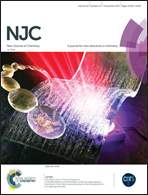Probing the competition between acetate and 2,2′-bipyridine ligands to bind to d-block group 12 metals†
Abstract
Herein, we were interested in probing the competition between 2,2′-bipyridine (2,2′-bipy) and acetate ligands in binding to Zn2+, Cd2+ and Hg2+. We have obtained eight new supramolecular architectures through tuning the proportion of these two ligands. On doubling the acetate availability compared to 2,2′-bipy, complexes with either Zn2+, Cd2+ or Hg2+ were formed with one 2,2′-bipy and two acetate ligands coordinated to the metal center. One water molecule is also coordinated to Zn2+ and Cd2+ in these two complexes, which are reported here for the first time. One 2,2′-bipy is still coordinated to the three metal ions with an acetate excess of 10-times, but another trinuclear Zn2+ complex is formed with two 2,2′-bipy and six acetate ligands (1 : 3 2,2′-bipy : acetate stoichiometry). Upon setting an equimolar ratio of the ligands, the complex [Zn(CH3CO2)(2,2′-bipy)2]+ is formed, while two 2,2′-bipy and two acetate ligands are coordinated to Cd2+, giving rise to a [Cd(CH3CO2)2(2,2′bipy)2] complex. On doubling the 2,2′-bipy availability compared to acetate, the former does not coordinate to Zn2+ and Cd2+, as observed in the acetate salt form of [Zn(2,2′-bipy)3]2+ and in [Cd(2,2′-bipy)3]2+. This last Cd2+ complex did not crystallize, revealing its unfavorable crystallization as an acetate salt form. However, under this last ligand ratio, the persistence of at least one coordinated acetate was observed in the Hg2+ complex with 2 : 1 2,2′-bipy : acetate stoichiometry. Furthermore, there is a cocrystallized 2,2′-bipy in the acetate salt form of [Hg(CH3CO2)(2,2′-bipy)2]+, which is not able to win the competition with acetate for the third coordination site to Hg2+. Even if the 2,2′-bipy amount is 10-times higher than that of acetate in the reaction batch, one acetate remains coordinated to Hg2+. Our crystal form of [Zn(CH3CO2)(2,2′-bipy)2]+ is strongly photoluminescent, with highly efficient emission centered at 356 nm (external and internal quantum yields of 14.2(1)% and 41.3(1)%), whose optical efficiency was rationalized on the basis of time-dependent DFT calculations.



 Please wait while we load your content...
Please wait while we load your content...